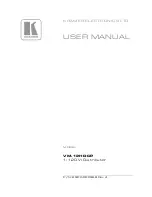
Adjusting Engine Idle
The engine must return to idle speed
whenever the throttle trigger is
released. Idle speed is adjustable,
and must be set low enough to per-
mit the engine clutch to disengage the
attachment.
Idle Speed Adjustment
1. Place the unit on the ground, then
start the engine, and then allow it to
idle 2-3 minutes until warm.
2. If the attachment rotates when the
engine is at idle, reduce the idle
speed by turning the idle adjusting
screw counter-clockwise.
3. If a tachometer is available, adjust
idle. Check Specifications page for
correct idle speed.
4. Carburetor fuel mixture adjustments
are preset at factory and cannot be
serviced in the field.
WARNING!
The attachment must
NEVER rotate at engine idle! If
the idle speed cannot be adjusted
by the procedure described here,
return the unit to your Shindaiwa
dealer for inspection.
Idle Adjusting
Screw
18
Carburetor Adjustment
Engine Break-In
New engines must be operated a minimum duration of two tanks of fuel break-in before carburetor adjustments can be
made. During the break-in period your engine performance will increase and exhaust emissions will stabilize. Idle speed can
be adjusted as required.
High Altitude Operation
This engine has been factory adjusted to maintain satisfactory starting, emission, and durability performance up to
1,100 feet above sea level (ASL) (96.0 kPa). To maintain proper engine operation and emission compliance above
1,100 feet ASL the carburetor may need to be adjusted by an authorized Shindaiwa service dealer.
NOTE:
Every unit is run at the factory and the carburetor is set in compliance with emission regulations. Carburetor adjustments,
other than idle speed, must be performed by an authorized Shindaiwa dealer.
IMPORTANT!
If the engine is adjusted for operation
above
1,100 feet ASL, the carburetor must be re-adjusted when operating the
engine
below
1,100 feet ASL, otherwise severe
engine damage may result.
Long Term Storage
Whenever the unit will not be used for
30 days or longer, use the following
procedures to prepare it for storage:
■
Clean external parts thoroughly
and apply a light coating of oil to all
metal surfaces.
■
Drain all the fuel from the carburetor
and the fuel tank.
To do so:
1. Prime the primer bulb until no more
fuel is passing through.
2. Start and run the engine until it
stops running.
3. Repeat steps 1 and 2 until the
engine will no longer start.
■
Remove the spark plug and pour
about 1/4 oz. of engine oil into the
cylinder through the spark plug hole.
Slowly pull the recoil starter 2 or
3 times so oil will evenly coat the
interior of the engine. Reinstall the
spark plug.
■
Before storing the unit, repair or
replace any worn or damaged parts.
■
Remove the air cleaner element
from the carburetor and clean it thor-
oughly with soap and water. Let dry
and reassemble the element.
■
Store the unit in a clean, dust-free
area.
CAUTION!
Gasoline stored in the carbure-
tor for extended periods can cause
hard starting, and could also lead to
increased service and maintenance
costs.
IMPORTANT!
All stored fuels should be stabi-
lized with a fuel stabilizer such as
STA-BIL™.
NOTE:
Damage resulting from stale or con-
taminated fuel is not covered by the
Shindaiwa warranty policy.
Troubleshooting Guide
Vaporlock.
Valve adjustment.
Engine hot/heat soaked.
Low fuel quality.
Valve clearance too tight.
Valve clearance too loose.
Let cool completely and restart.
Refi ll with fresh, clean unleaded gasoline with a pump octane
of 89 or higher mixed with an air cooled engine oil that
meets or exceeds ISO-L-EGD and/or JASO FD classifi ed oils
at 50:1 gasoline/oil ratio.
Consult with an authorized Shindaiwa
servicing dealer. Adjust valves.
What To Check
Possible Cause
Remedy
ENGINE DOES NOT START OR HARD TO START
NO
NO
NO
NO
Does the engine crank?
Good compression?
Does the tank contain fresh
fuel of the proper grade?
Is fuel visible and moving
in the return line when
priming?
Is there spark at the spark
plug wire terminal?
Check the spark plug.
Faulty recoil starter.
Fluid in the crankcase.
Internal damage.
Loose spark plug.
Excess wear on cylinder,
piston, rings.
Fuel incorrect, stale, or
contaminated; mixture incorrect.
Check for clogged fuel fi lter
and/or vent.
Priming pump not functioning properly.
The ignition switch is in
“O” (OFF) position.
Shorted ignition ground.
Faulty ignition unit.
If the plug is wet, excess
fuel may be in the cylinder.
The plug is fouled or improperly
gapped.
The plug is damaged internally
or of the wrong size.
Consult with an authorized Shindaiwa servicing dealer.
Tighten and re-test.
Consult with an authorized Shindaiwa
servicing dealer.
Refi ll with fresh, clean unleaded gasoline with a pump octane
of 89 or higher mixed with an air cooled engine oil that
meets or exceeds ISO-L-EGD and/or JASO FD classifi ed oils
at 50:1 gasoline/oil ratio.
Replace fuel fi lter or vent as required.
Re-start.
Consult with an authorized Shindaiwa
servicing dealer.
Move switch to “I” (ON) position
and re-start.
Consult with an authorized Shindaiwa
servicing dealer.
See "Starting a Flooded Engine"
Clean and gap the spark plug. Check the Specifi cations
section for the correct plug and gap for your unit. Restart.
Replace the spark plug. Check the Specifi cations section for
the correct plug and gap for your unit. Restart.
NO
YES
What To Check
Possible Cause
Remedy
ENGINE DOES NOT START
YES
YES
YES
YES











































